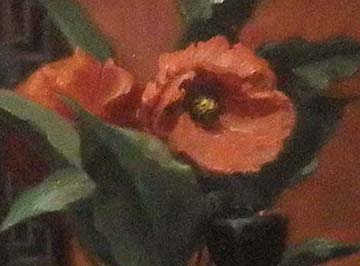My favorite red pigment used by ancient Greeks is cinnabar. It was a perfect hue to use on these poppies. I used burnt umber and madder for the shadow tones, and heightened the lights with yellow ochre and white. A very similar hue can be attained by using vermilion, a much more intense in color. Just calm the heat with a nice earthy green. By doing this, it becomes a lovely subtle tone. Natural cinnabar can be quite gritty which is a desirable quality for me.


Poppies Poppin out all over…this is such a vibrant red! very sweet.
Dear Margret,
I had the idea that cinnabar and vermilion were the same.
Both derive from mercury, right ?
Doesn’t the name vary according to the use ?
Best regards,
José
Hello Jose,
A good way to think about these two pigments is this. Cinnabar is the mineral that is made in nature from a combination of sulfur and mercury. It is mined and crushed into a pigment.
Genuine vermilion is made from the same two components, sulfur and mercury, but it is manufactured in the laboratory. The results are close in hue with only slight variations. This form was invented by the Chinese thousands of years ago.
Hope this analysis helps.
Best Regards,
Margret